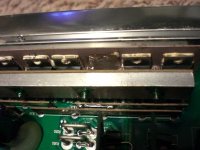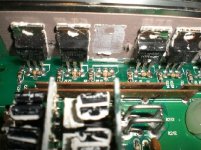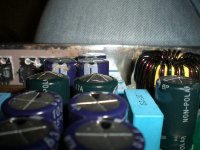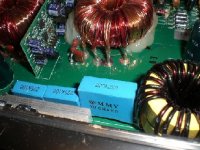I just opened a Memphis ST-1500d and it looks like somebody removed 2 FET's without removing the hold down bracket because the tamper proof glue is still on the screws. Is this possible? Or was yhis done on the assembly line? 2 pictures one left side bar removed and the right side not removed. Has anybody seen this before?







Attachments
Someone removed them. They probably loosened the screw enough to release the transistor, cut the legs (or pulled hard enough to break the legs) and pulled it out. It's also possible that the screw was removed but the thread-locking compound remained on the clamp.
If the screws have never been completely removed, you may want to place a drop of acetone on each screw to soften the thread-locking compound. It will make removing the screws much easier. The heads of these screws are easily stripped so be careful.
The transistors that have their 3rd legs tied to the missing one are the same part number as the missing one.
If the screws have never been completely removed, you may want to place a drop of acetone on each screw to soften the thread-locking compound. It will make removing the screws much easier. The heads of these screws are easily stripped so be careful.
The transistors that have their 3rd legs tied to the missing one are the same part number as the missing one.
Perry... I just went to Ampguts and looked at the pics of another Memphis 16-ST1500d and they are missing on that one too. ??? So I guess it was built like that? Weird!
??? So I guess it was built like that? Weird!
Anyway I have 3 - 200volt 20uf and 2- 10uf capacitor's with the top bulging, What should I look for causing this?
 ??? So I guess it was built like that? Weird!
??? So I guess it was built like that? Weird!Anyway I have 3 - 200volt 20uf and 2- 10uf capacitor's with the top bulging, What should I look for causing this?
Attachments
The transistors were definitely on the sink at one time. You can see the outline of the transistor in the grease.
The caps that vented are definitely defective. It's unlikly that you'll be able to get them from Memphis.
The caps probably failed from too much ripple current. This could have been from too low of an ohm load or a defective inductor.
I can't really tell anything from the second photo. If you remove it and it's not shorted, it's probably OK. When you touch your leads across the cap (meter set to ohms), it should initially show low resistance, then go to OL. It will only do this once. To do it a second time, you'll have to reverse the position of the leads on the cap.
The caps that vented are definitely defective. It's unlikly that you'll be able to get them from Memphis.
The caps probably failed from too much ripple current. This could have been from too low of an ohm load or a defective inductor.
I can't really tell anything from the second photo. If you remove it and it's not shorted, it's probably OK. When you touch your leads across the cap (meter set to ohms), it should initially show low resistance, then go to OL. It will only do this once. To do it a second time, you'll have to reverse the position of the leads on the cap.
If the transistors are also missing on the ampguts site, its probably a common problem area on the amp. They were obviously there if the compound still has an imprint. Perry, I think he's talking about the little red cap next to the transfomer and the large resistor. You can see its a little dark from doing its job.
Yea, I just can't figure it out. On the FET hold down bar it has a peice of thin cardboard an it has the imprint of every FET but the one that is missing. If it wasn't for the indention in the paist I would be almost positive the FET didn't belong there. Very Strange.
Here is the ampguts link.
http://ampguts.realmofexcursion.com/Memphis_16-ST1500D/inside4.jpg
Here is the ampguts link.
http://ampguts.realmofexcursion.com/Memphis_16-ST1500D/inside4.jpg
ppia600:
I think the red cap is simply dark from poor lighting but I could be wrong. When I zoom in on it, I can see what looks like a dark spot near its center but the low resolution makes it difficult to determine if it's really a defect or an artifact in the photo. I thought he was talking about the 2.2uf 250v cap near the inductor.
Itsme:
It's possible that they received the assembled amps and found that there was a problem (too much drive current causng drivers to fail, a problem with the circuit board layout...). If that's the case, they may have disassembled the amps, removed the transistors and reassembled them with new clamps.
I think the red cap is simply dark from poor lighting but I could be wrong. When I zoom in on it, I can see what looks like a dark spot near its center but the low resolution makes it difficult to determine if it's really a defect or an artifact in the photo. I thought he was talking about the 2.2uf 250v cap near the inductor.
Itsme:
It's possible that they received the assembled amps and found that there was a problem (too much drive current causng drivers to fail, a problem with the circuit board layout...). If that's the case, they may have disassembled the amps, removed the transistors and reassembled them with new clamps.
- Status
- This old topic is closed. If you want to reopen this topic, contact a moderator using the "Report Post" button.
- Home
- General Interest
- Car Audio
- Memphis missing FET's?



